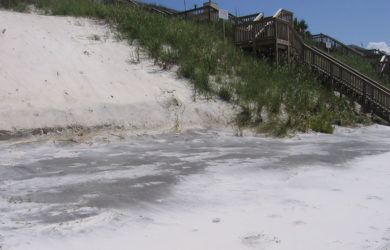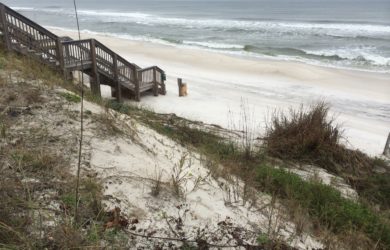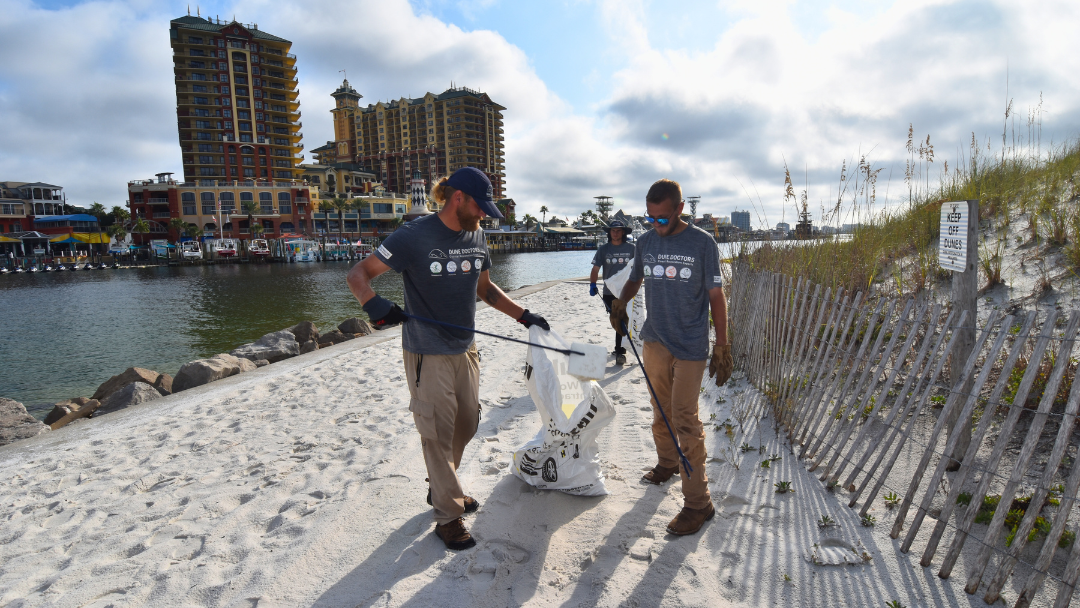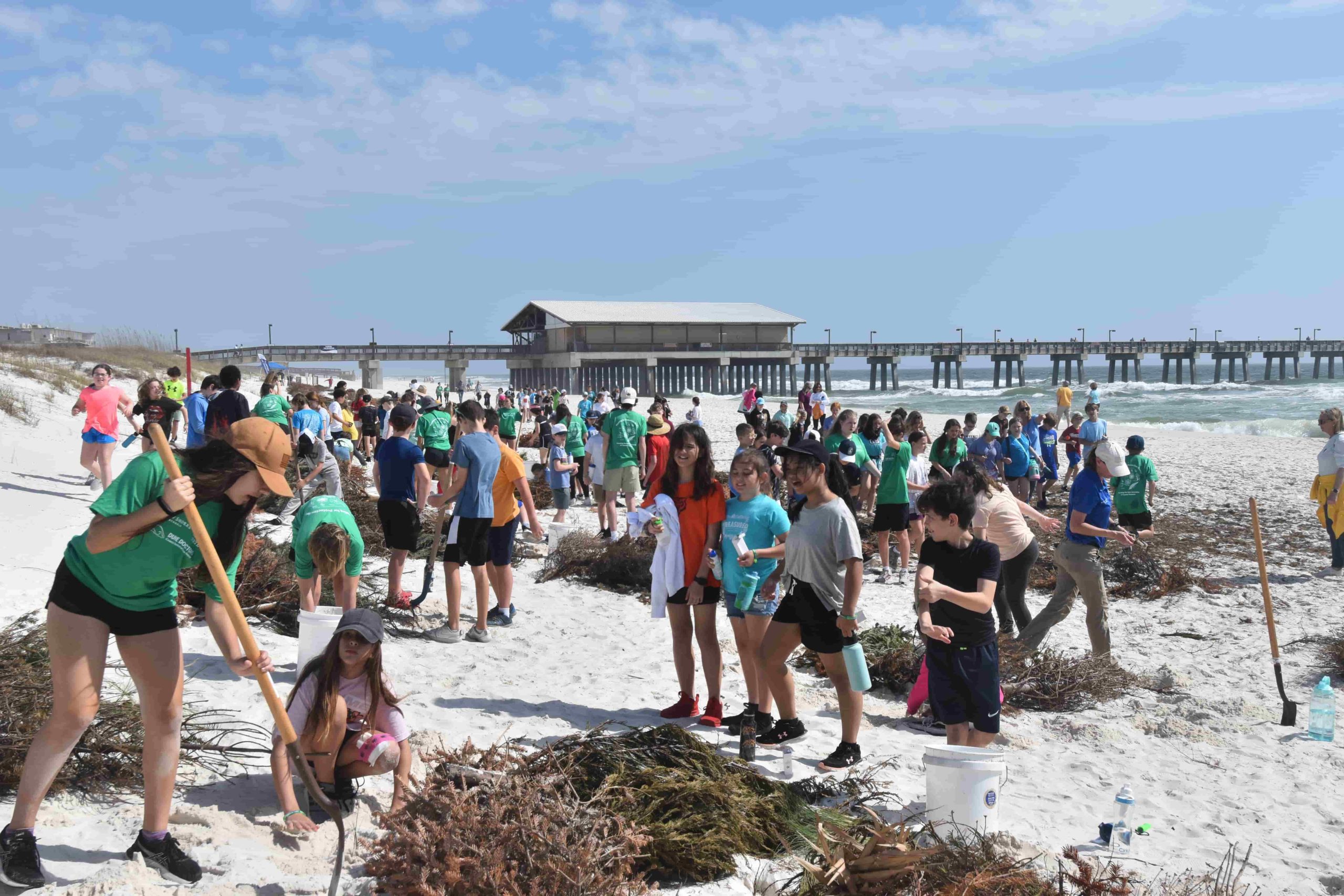Along the eastern seaboard and Gulf states, sea oats help limit coastal erosion. Dune vegetation is one, if not the most crucial, part of the successful building and stabilization of dunes. Unlike other plants, they can thrive on the beach because of two properties: a robust root system with a web-like quality and the ability to continue to grow upwards despite being repeatedly covered in sand. Through this cycle of sand accretion, the plant actively expands its root system and widens the hurricane defense barrier. Sea oats are so instrumental to the sustainability of our beaches that the plants receive government protection in most states. Sea oats stabilize the dune allowing the ecosystem to thrive, and to maximize the plant’s effectiveness, routine maintenance is advisable.
Sea Oats are Critical to help limit Coastal Erosion
 The image to left depicts a dune partially covered in vegetation. The section that is bare lost $5,000 to $7,000 worth of sand due to enormous erosion brought on by a storm. However, if you look closely, you can observe roots sticking out of the cliff. This growth indicates that the adjacent plants’ web-like root systems that are 15 ft away helped hold the remaining sand in place. Healthy sea oats can help you avoid tremendous loss by anchoring your protective berm in the face of coastal storms.
The image to left depicts a dune partially covered in vegetation. The section that is bare lost $5,000 to $7,000 worth of sand due to enormous erosion brought on by a storm. However, if you look closely, you can observe roots sticking out of the cliff. This growth indicates that the adjacent plants’ web-like root systems that are 15 ft away helped hold the remaining sand in place. Healthy sea oats can help you avoid tremendous loss by anchoring your protective berm in the face of coastal storms.
How Do Sea Oats Anchor the Dunes?
While there are many types of plants that protect against coastal erosion, sea oats are the most prevalent (and critical) species along the coast in America. According to a fact sheet provided by the USDA, mature sea oats’ leaves reach about 24 inches in length and their flowers reach about 6 feet in height. At the base of the plant, there are special stems that have bulges or nodes. These bulges will “root down and anchor to the soil surface” as the wind carries sand over the plant. Sea oats also produce rhizomes that are, in part, responsible for the plants’ expansion and colonization of the dunes. Those rhizomes also help strengthen the thick mesh-like quality of the plants’ complex root system. Sand accretion stimulates the plants to grow sideways by pinning down these stems and encouraging new root systems to grow from its nodes. The sand burial cycle is critical because it encourages the plants to fight for their survival by pushing through the particles of sand with their new stems widening the plants’ grip on the sand dune. Most importantly, it buries any dead organic material from the plants and allows it to decompose, under the sand, into nutrition that seeps down to the roots.
What is Thatch?
Sea oats are sometimes susceptible to the accumulation of thatch (dead plant material) around the base of the plant. This buildup proves detrimental to the plant’s health and jeopardizes the role the plant plays in the dune’s ecosystem. Thatch is a form of mulch. Mulch can be comprised of many substances–dried plant material, wood chips/bark, coconut husks, gravel, even shredded rubber. The function of mulch is to keep moisture in the ground. On the dunes, thatch is composed of the plants’ dead/spent leaves and stems that remained above the sand. This buildup forms a mass of dead plant material that mats together in a clump resembling a ball of yarn at the base of the plant. One might assume thatch would be beneficial to the plants (by providing nutrients and moisture retention) and should therefore not be removed. However, if thatch accumulates faster than sand accretion can bury it the sea oats can reach a plateau in their growth.
How does Thatch Adversely Affect Dune Vegetation?
Sea oats stabilize the dune they grow on by sending out deep roots in search of water. But, in order to do so, the plants need nutrients that can support this endeavor. A buildup of thatch creates multiple problems: it encourages shallow roots, does not decompose into nutrition for the plant, and can harbor diseases and pests. This clump of rotting organic material concentrates moisture at the surface of the soil. With access to a shallow water source, the plants no longer need to send out deep roots and offer no protection to the dune. When left unburied, thatch cannot decompose to become the nutrients the plants need to grow throughout the dune. Thatch creates an environment favorable for diseases to proliferate, often proving fatal to the plant. Furthermore, the buildup provides a place for non-native rats and snakes to lay claim to the dunes. If you are noticing an increase in snakes around your property, check out our comprehensive guide on how to address this issue.
Sea Oats on the Dunes’ Slope Are Most at Risk
 When observing a constructed dune, typically, the sea oats at the base of the dune are the tallest and strongest. The plants on the dune’s slope tend to be shorter and less robust by comparison. The main difference between the two plants is that the sea oats at the foot of the slope undergo the process of cyclical sand accretion while the plants on the slope remain unburied. Thatch begins to accumulate at the base of the plants on the slope as their spent leaves and stems remain above the surface of the sand. The presence of high moisture at the sand’s surface (from this thatch/mulch), in turn, causes the plants to develop shallow root systems and stunted growth. These plants become weak and very easy to uproot. The sea oats growing on the incline of the slope are critical to holding the formation in place just as the ones present at the base of the slope are critical to expanding the dune. Since those plants do not go through the cycle of getting buried, they are the ones that most need maintenance.
When observing a constructed dune, typically, the sea oats at the base of the dune are the tallest and strongest. The plants on the dune’s slope tend to be shorter and less robust by comparison. The main difference between the two plants is that the sea oats at the foot of the slope undergo the process of cyclical sand accretion while the plants on the slope remain unburied. Thatch begins to accumulate at the base of the plants on the slope as their spent leaves and stems remain above the surface of the sand. The presence of high moisture at the sand’s surface (from this thatch/mulch), in turn, causes the plants to develop shallow root systems and stunted growth. These plants become weak and very easy to uproot. The sea oats growing on the incline of the slope are critical to holding the formation in place just as the ones present at the base of the slope are critical to expanding the dune. Since those plants do not go through the cycle of getting buried, they are the ones that most need maintenance.
Dry Thatch Poses a Fire Hazard
In a long period of drought (when rain does not wet the accumulated thatch), the thatch dries out, making it extremely flammable. This dry thatch poses a significant fire hazard that a cigarette butt, 4th of July fireworks, or other accidental sparks can easily ignite. According to Panama City News Herald, in 2018, roughly 1.5 acres of federally protected land by the Destin bridge caught on fire due to illegal firework activity. The fire spread quickly as various emergency response teams attempted to stop it. Properties that do not regularly dethatch may be at an increased risk of undergoing a similar fate.
Academic Efforts to Protect Sea Oats
With the ability to thrive in saline environments with high temperatures, droughts, and temporary inundations, sea oats help defend the shoreline against erosion. For the Alabama and North West Florida Coast the 2004 & 2005 hurricane seasons were a wake-up call in that the storms damaged or destroyed much of the natural sea oats population that serve as seed sources to generate new plants. Because of how critical the plant is to dune preservation, Michael Kane an environmental horticulture professor for the University of Florida, spearheaded a project to cryogenically freeze thousands of sea oat samples from all major sea oat populations along Florida’s coast. In addition to this particular sea oats library, other universities ensure that genetic variety is kept with banking seeds from different areas. The importance of this plant for dune preservation cannot be overstated and should be protected for future generations.
Leave the Maintenance to Professionals
We have discussed the importance of removing thatch, but not everyone is qualified to remove it. Since very few plants can grow as their bases are covered, sea oats are accustomed to anchoring themselves with “dense root webs.” When thatch accumulates, sea oats are in a weakened state and are more likely to be accidentally pulled from the soil. Therefore, it is highly recommended that only a team of qualified professionals, who have a working understanding of the plant’s nature, be the ones to remove the accumulated thatch. Sea oats are vital to successful dune preservation. It is our job as Coastal Stewards to protect and nurture them to the best of our ability. If your dune vegetation is undergoing the cycle of sand accretion, then mother nature handles the dead organic material. However, if you are in a situation where your plants are not undergoing natural sand accumulation, you should get professional help.
Sources:
“Freezing Sea Oats.” Florida Sea Grant, 27 Sept. 2017, www.flseagrant.org/news/2012/09/sea-oats/. ,
Osbourne, Heather. “Fire Chief: Fireworks Likely Started Destin Fire.” Panama City News Herald, Panama City News Herald, 6 July 2018, www.newsherald.com/news/20180706/fire-chief-fireworks-likely-started-destin-fire.
R. Alan Shadow. Plant Fact Sheet SEA OATS. Plant Fact Sheet SEA OATS, plants.usda.gov/factsheet/pdf/fs_unpa.pdf.






